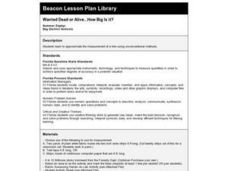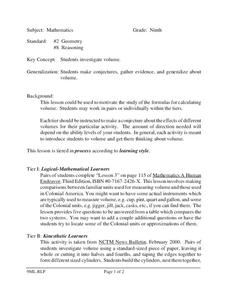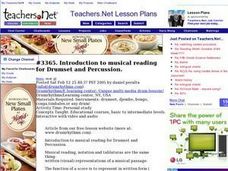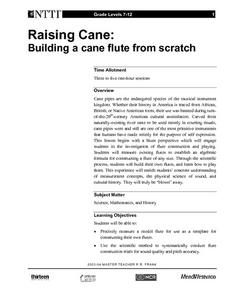Curated OER
Oranges and Stopwatches
Students begin to recognize that objects have many measurable attributes. They examine how to identify and accurately measure attributes of common objects. Also Students report their measurement findings.
Curated OER
How to Read a Thermometer
Students' temperature is measured using an instrument called a thermometer.
Curated OER
Rearrange the Room
Second graders measure and grid their ideas for the new classroom floor plan. They create their own ideas for the classroom arrangement on grid paper. When they finish, they share their draft plan with their peers and with the teacher...
Curated OER
Air Pressure is Powerful
Students construct a barometer and collect data on the changes in air pressure. They work is small groups using plastic tubing, corks, and green food coloring. They then use a formula to convert inches of mercury to barometric pressure...
Curated OER
Wet Weather, Wet Climate
Students discover the differences between weather and climate in this long-term lesson introduction. They create rain gauges and practice reading rainfall measurements, view a website showing the cloud cover in their location and draw...
Curated OER
Creating, Notating and Recording an Original Song
Learners are provided with a set of parameters, including theme, time
signature, number of measures, and form. Working within these parameters, the class , step by step, goes through the process of
creating, notating, and recording a...
Curated OER
Wanted Dead or Alive...How Big Is it?
Fourth graders estimate the measurements of trees using unconventional techniques.
Curated OER
Someone Is In The Kitchen
Learners investigate the lifestyles of the Native Americans and look at a recipe found on a website. They read the recipe and pay attention to the measurements. They differentiate between the various measures in order to apply them to...
Curated OER
Critter? Growth
Students identify and use the elements of the scientific inquiry to solve problems. They explain concepts about the structure and properties of matter. Pupils write an explanation of polymers and how the characteristic of polymers...
Curated OER
Vectors
Students differentiate distance and displacement. In this physics lesson, students use formulas to calculate for displacement. They draw vectors using the grid.
Curated OER
The Colors on My TV Screen
Pupils explore how electronic screens use only three colors to produce the colors that people see on the screen. They make and test a color wheel.
Curated OER
TE Activity: Ohm's Law 2
Students study Ohm's Law 2 after completing an activity about Ohm's Law 1. They determine how long it takes to charge a battery. They examine if it is better to use batteries in series or parallel circuits.
Curated OER
Tangram Perimeters
Students work together to make figures out of tangram squares. In groups, they calculate the measurements they need and apply the Pythagorean Theorem. They complete a worksheet solving equations using the theorem and review their answers.
Curated OER
Investigating Volume
Ninth graders investigate and make conjectures about volume. In this geometry lesson, 9th graders analyze data and predict the outcome. They calculate volume using different tiers.
Curated OER
If I Can't See It, How Do I Know It's There?
Students build a model ocean using a variety of materials representing the various levels of the ocean. They collect data about the ocean floor in a partner activity. They practice working with topographical mapping grids.
Curated OER
Searching the Attic
Students investigate an attic or basement to "discover" family artifacts. They develop a grid map using string, create a naming system for the grid, and analyze items of interest.
Curated OER
Sugar Bush Sap Production - Human Environmental Impact on Sap Sand
Eleventh graders compare the amount of sugar sand present in tree sap. In this environmental science lesson plan, 11th graders measure different tree circumference. They prepare a report and share findings in class.
Curated OER
Who Stole My Salad?
Eighth graders explain how protein is made in the cell. In this biology lesson, 8th graders translate RNA and DNA using an internet database. They determine the thief based on evidence collected.
Curated OER
Parts of Similar Triangles
In this parts of similar triangles activity, 10th graders solve and complete 15 different statements related to naming the parts found in similar triangles. First, they identify each definition stated that describes an everyday usage of...
Curated OER
Introduction to musical reading for Drumset and Percussion.
Students analyze the functions of musical scores as they relate to percussion instruments. They follow an audio and video presentation as they count and follow beat patterns.
Curated OER
Marching Band Cadence
Students compose an original cadence. They compose a short segment (2 measures) of a cadence on staff paper. Papers are collected and entered into Sibelius program. They compose original cadences using the Sibelius program and...
Curated OER
Investigate Factors Affecting Nitrates in Groundwater
Pupils participate in an experiment in which they investigate the factors affecting the levels of nitrates in groundwater. Using examples, they explain the nitrogen cycle and identify the sources of chemical nitrogen fertilizers. They...
Curated OER
Raising Cane: Building a Cane Flute From Scratch
Eighth graders create their own cane flute. They use a model flute to gain the correct measurements and use the scientific method to construct the flute to have sound quality and pitch accuracy.
Curated OER
Angles, Parallel Lines, and Polygons
Learners examine how to investigate polygons using an instrument of their own construction. They should be able to prove the general formula for the number of degrees in any polygon (including a triangle). Finally they investigate an...

























